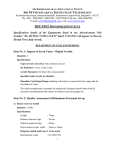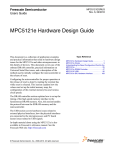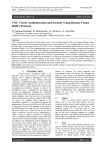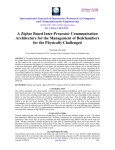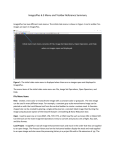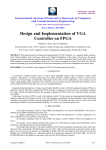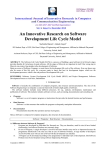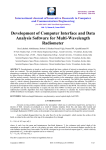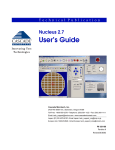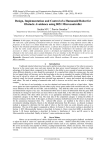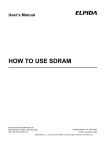Download Design and Verification of High Speed SDRAM Controller
Transcript
ISSN(Online): 2320-9801 ISSN (Print): 2320-9798 International Journal of Innovative Research in Computer and Communication Engineering (An ISO 3297: 2007 Certified Organization) Vol. 2, Issue 6, June 2014 Design and Verification of High Speed SDRAM Controller with Adaptive Bank Management and Command Pipeline Ganesh Mottee, P.Shalini Mtech student, Dept of ECE, SIR MVIT Bangalore, VTU university, Karnataka, India. Assistant Professor, Dept of ECE, SIR MVIT Bangalore, VTU university, Karnataka, India . ABSTRACT: As the performance gap between microprocessors and memory continues to increase,main memory accesses result in long latencies which become a factor limiting system performance. Previous studies show that main memory access streams contain significant Localities and SDRAM devices provide parallelism through multiple banks and channels.These locality and parallelism have not been exploited thoroughly by conventional memory controllers. In this thesis, SDRAM address mapping techniques and memory access reordering mechanisms are studied and applied to memory controller design with the goal of reducing observed main memory access latency. The application of the synchronous dynamic random access memory (SDRAM) has gone beyond the scope of personal computers for quite a long time. It comes into hand whenever a big amount of low price and still high speed memory is needed. Most of the newly developed stand alone embedded devices in the field of image, video and sound processing take more and more use of it. The big amount of low price memory has its trade off – the speed. In order to take use of the full potential of the memory, an efficient controller is needed. Efficient stands for maximum random accesses to the memory both for reading and writing and less area after implementation. I. INTRODUCTION The High-Speed SDRAM Controller offers storage extension for memory critical applications. For example with packet-based traffic as in IP networks, storage requirements can become crucial when complete frames need to be stored . The Controller implements a burst optimized access scheme, which offers transfer rates up to 4 Gbit/s at 125MHz. All SDRAM device specifics, like row and column multiplexing, page burst handling; page and bank switching are completely hidden from the user application. Power-up initialization, refresh and other management tasks necessary to provide data integrity in the SDRAM are done automatically and also hidden from the user application. The Controller interfaces directly to SDRAM memory devices and provides a simple and easy-to-use split-port user interface (separate read and write ports). It allows for single word accesses as well as arbitrary length bursts emulating a linear memory space with no page or bank boundaries. The SDRAM Controller can easily be connected to other MorethanIP solutions or us backend for large FIFO application II. RELATED WORK Synchronous DRAM (SDRAM) has become a mainstream memory of choice in embedded system memory design. For high-end applications using processors the interface to the SDRAM is supported by the processor’s built-in peripheral module. However, for other applications, the system designer must design a controller to provide proper commands for SDRAM initialization, read/write accesses and memory refresh. This SDRAM controller reference design, located between the SDRAM and the bus master, reduces the user’s effort to deal with the SDRAM command interface by providing a simple generic system interface to the bus master. Figure 1 shows the relationship of the controller between the bus master and SDRAM. The bus master can be either a microprocessor or a user’s proprietary module interface. SDRAM is high-speed Dynamic Random Access Memory (DRAM) with a synchronous interface. The synchronous interface and fully pipelined internal architecture of SDRAM allows extremely fast data rates if used efficiently. SDRAM is organized in banks of memory addressed by row and column. The number of row and column address bits depends on the size and configuration of the memorySDRAM is controlled by bus commands that are formed using Copyright to IJIRCCE www.ijircce.com 4802 ISSN(Online): 2320-9801 ISSN (Print): 2320-9798 International Journal of Innovative Research in Computer and Communication Engineering (An ISO 3297: 2007 Certified Organization) Vol. 2, Issue 6, June 2014 combinations of the ras_n, cas_n, and we_n signals. For instance, on a clock cycle where all three signals are high, the associated command is a No Operation (NOP). A NOP is also indicated when the chip select is not asserted. Fig 2.1 Table of command These banks must be opened before a range of addresses can be written to or read from. The row and bank to be opened are registered coincident with the Active command. When a new row on a bank is accessed for a read or a write it may be necessary to first close the bank and then re-open the bank to the new row. Closing a bank is performed using the Prec command. Opening and closing banks costs memory bandwidth, so the SDRAM Controller Core has been designed to monitor and manage the status of the four banks simultaneously. This enables the controller to intelligently open and close banks only when n When the Read or Write command is issued, the initial column address is presented to the SDRAM devices. The initial data is presented concurrent with the Write command. For the read command, the initial data appears on the data bus 1 known as CAS latency and is due to the time required to physically read the internal DRAM andregister the data on the bus. The CAS latency depends on the speed frequency of the memory clock. In general, the faster the clock, the more cycles of CAS latency is required. After the initial Read or Write command, sequential read and writes will continue until the burst length is reached or support a burst length of up to 8 data cycles. The SDRAM Controller Core is capable of cascading bursts to maximize SDRAM bandwidth. Fig 2.1 Table of command1-4 clock cycles later. This is grade of the SDRAM and thea Burst Terminate command is issued. SDRAM devices command Precharge necessary SDRAM devices require periodic refresh operations to maintain the data. The SDRAM Controller Core automatically issues the Auto Refresh comman periodically. No user intervention is required The Load Mode Register command is used to configure the SDRAM operation. This register stores the CAS latency, burst length, burst type, and write burst mode. The SDR controller only writes to the base mode register Non-adaptive controller opens and closes banks for each transaction. SDRAM command time sequence for two sequential block writing to the same bank like: Fig 2.2 Nonadaptive controller opens and closes bank for each transactions Consider SDRAM command sequence for block writing with closed bank a and to the row controller keeps these banks open also. Then the sequence for non the following: Consider SDRAM command sequence for block writing with Burst Length equal to 4 to closed bank a and to the row 1 of bank b with opened row 0. Assume, that the non-adaptive controller keeps these banks open also. Then the sequence for non adaptive controller will be the following Copyright to IJIRCCE www.ijircce.com 4803 ISSN(Online): 2320-9801 ISSN (Print): 2320-9798 International Journal of Innovative Research in Computer and Communication Engineering (An ISO 3297: 2007 Certified Organization) Vol. 2, Issue 6, June 2014 III. PROPOSED ALGORITHM HSSDRC IP Core keeps all banks open and closes them only to change row or for memory refresh and SDRAM command sequence for two sequential block writing will be : These two write transaction will consume 11 clock ticks. It gives a benefit of 8 clock ticks or 42 % of a memory write bandwith. This bank access algorithm is called here as “Adaptive SDRAM bank control“. Command NOP is a mandatory pause in operation of the SDRAM command pipeline in the above sequences HSSDRC IP Core bank control commands for next memory access are inserted in place of these mandatory pauses whenever possible. Then the command sequence will be the following (best case is shown): These two write transactions will consume 11 clock ticks. It gives a benefit of 8 clock tick or 42 % of a memory write bandwith again. SDRAM command sequence for HSSDRC IP core do not have Twr time interval because this sequence does not need it in the example above. This algorithm for filling of mandatory NOP pauses with meaningful commands in the SDRAM command pipeline is called here as “Adaptive command pipeline control“. Fig 4..SDRAM Block Diagram . Copyright to IJIRCCE www.ijircce.com 4804 ISSN(Online): 2320-9801 ISSN (Print): 2320-9798 International Journal of Innovative Research in Computer and Communication Engineering (An ISO 3297: 2007 Certified Organization) Vol. 2, Issue 6, June 2014 4.1 Refresh window generator module While the memory is operating, each memory cell must be refreshed repetitively, within the maximum interval between refreshes specified by the manufacturer, which is millisecond region. Refreshing does not employ the normal memory operations (read and write cycles) used to access data, but specialized cycles called generated by separate counter circuits in the memory circuitry a normal memory accesses. The storage cells on a memory chip are laid out in a rectangular array of rows and columns. 4.2 Input arbiter module Contains round-robin arbiter for three independent SDRAM command decoders. A roundrobin token passing bus or switch arbiter guarantees fairness (no starvation) among masters allows any unused time slot to be allocated to a master whose round-robin turn is later but who is ready now A reliable prediction of the worst-case wait time is another advantage of the round-robin protocol. The worst-case wait time is proportional to number of requestors minus one. The protocol of a round-robin token passing bus or switch arbiter works as follows. In each cycle, one of the masters (in round-robin order) has the highest priority (i.e., owns the token) for access to a shared resource. If the token-holding master does not need the resource in this cycle, the master with the next highest priority who sends a request can be granted the resource, and the highest priority master then passes the token to the next master in round-robin order. 4.3 SDRAM memory bank using map module Contains memory for storage of the open bank and row indexes. This memory state is changed by SDRAM command decoders. 4.3.1 Memory bank A memory bank is a logical unit of storage in electronics, which is hardware dependent. In computer the memory bank may be determined by the memory access controller along with physical organization of the hardware memory slots. In a typical synchronous dynamic random-access memory (SDRAM) or double data rate synchronous dynamic randomaccess memory (DDR SDRAM), a bank consists of multiple rows and columns of storage units and is usually spread out across several chips. In a single read or write operation, only one bank is accessed, therefore bits in a column or a row, per bank, per chip = memory bus width in bits (single channel). The size of a bank is further determined by bits in a column and a row, per chip× number of chips in a bank. 4.4 SDRAM command sequence decoders module Contains three independent SDRAM command sequence decoders. The proper SDRAM command sequence is chosen depending upon information from memory bank usage map. DECODER Fig 4.4 Decoder Copyright to IJIRCCE www.ijircce.com 4805 ISSN(Online): 2320-9801 ISSN (Print): 2320-9798 International Journal of Innovative Research in Computer and Communication Engineering (An ISO 3297: 2007 Certified Organization) Vol. 2, Issue 6, June 2014 After the arbiter has accepted a command from the host, the command is passed onto the command generator portion of the command module. The command module uses three shift registers to generate the appropriate timing between the commands that are issued to SDRAM. One shift register is used to control the timing the ACTIVATE com second is used to control the positioning of the READA or WRITEA commands; a third is used to time com- mand durations, which allows the arbiter to determine if the last operation has been completed. The command module also performs the multiplexing of the address to the SDRAM. The row portion of the address is multiplexed out to the SDRAM outputs A[11:0] during the ACTIVATE(RAS) command. The column portion is then multiplexed out to the SDRAM address outputs during a READA(CAS) or WRITEA command. The output signal OE is generated by the command module to control tristate buffers in the last stage of the DATAIN path in the data path module. 4.5 Output arbiter module Module contains round-robin arbiter and adaptive access to SDRAM command pipeline logic, analyzing decoded commands and SDRAM banks state taken from access manager. 4.5.1 Round robin arbiter Round robin arbitration is a scheduling scheme which gives to each requestor its share of using a common resource for a limited time or data elements. The basic algorithm implies that once a requestor has been serves he would “go around” to the end of the line and be the last to be served again. The simplest form of round robin arbiter is based on assignment of a fixed time slot per requestor; this can be implemented using a circular counter. Alternatively, the weighted round robin arbiter is defined to allow a specific number X of data elements per each requestor, in which case X data elements from each requestor would be processed before moving to the next one. Round robin arbiters are typically used for arbitration for shared resources, load balancing, queuing systems, and resource allocation. Any application requiring a minimal fairness where none of the requestors is suffering from starvation is a valid application for a round robin arbiter. Fig 4.5 round robin arbiter 4.6 . SDRAM command pipeline access manager module Contains FSMs for each memory bank. Module permits or inhibits access to given SDRAM bank. In the state idle the main FSM accepts from the scheduler the best fitting requestor and splits the request into bank access (states: serve bank0 – serve bank3). In case of a pending refresh the main FSM indicates the command generation unit the scheduled refresh with the signal start refresh (state: serve refresh). The main FSM breaks the access granularity from requestor level down to bank accesslevel.The scheduler provides the main FSM with the information about the best fitting requestor, according to the arbitration policy. The main FSM accepts with a handshake the requestor prepares the Copyright to IJIRCCE www.ijircce.com 4806 ISSN(Online): 2320-9801 ISSN (Print): 2320-9798 International Journal of Innovative Research in Computer and Communication Engineering (An ISO 3297: 2007 Certified Organization) Vol. 2, Issue 6, June 2014 access. Therefore, it routes the target address of the selected requestor to the address mapping unit. Furthermore, the main FSM indicates to the command Fig 4.6. FSM 4.7 SDRAM initialization module Contains counter-based FSM creating necessary command chain for SDRAM initialization. The Controller has to go through an initialization process by a sequence of command signals before the normal memory access.The memory controller starts the memory initialization sequence when the init_start signal is asserted by the user interface. Once asserted, the init_start signal needs to be held high until the initialization process is com-pleted. The output signal init_done is asserted High for one clock cycle indicating that the core has com-pleted the initialization sequence and is now ready to access the memory. The init_start signal must be deasserted as soon as init_done is sampled high at the rising edge of sclk. If the init_start is left high at the next rising edge of sclk the memory controller takes it as another request for initialization and starts the initialization process again. Memory initialization is required only once immediately after the system reset. As part of Initialization the core performs write leveling for all the available ranks and stores the write level delay values. The memory controller ensures a minimum gap of 500 μs between em_ddr_reset_n deassertion and em_ddr_cke assertion. It is user’s responsibility to ensure minimum reset duration of 200 μs. 4.8. Logical command multiplex module Contains simple command multiplexer for mixing outputs of output arbiter and initialization module. Because of controller being passive during initialization routine due to internal synchronous reset of all decoders and arbiters, multiplexing is substituted with logical OR. 4.9 Datapath module Contains FSM for access to read/write data and SDRAM masking logic. The data flow design between the SDRAM and the system interface is shown in figure. The datapath circuit consists of four number of 16-bit D flip flops and a tristate buffer. Flip flop is used to shift the data. Tristate buffer is used to determine the direction of bidirectional data bus. Tri state buffer has a control input which determines whether it is a read or write operation. Copyright to IJIRCCE www.ijircce.com 4807 ISSN(Online): 2320-9801 ISSN (Print): 2320-9798 International Journal of Innovative Research in Computer and Communication Engineering (An ISO 3297: 2007 Certified Organization) Vol. 2, Issue 6, June 2014 Fig 4.9 Datapath 4.10. Address-path module Once the memory initialization is done, the core waits for user commands in order to setup and/or access the memory. The user logic needs to provide the command and address to the core along with the control signals. The com-mands and addresses are delivered to the core using the following procedure. The memory controller core informs the user logic that it is ready to receive a command by asserting the cmd_rdy signal for one cycle. If the core finds the cmd_valid signal asserted by the user logic while it’s cmd_rdy is asserted, it takes the cmd input as a valid user command. IV. SIMULATION RESULTS 5.1.1 Adaptive bank management HSSDRC IP Core keeps all banks open and closes them only to change row or form memory refresh and SDRAM command sequence for two sequential block writing will be The simulated result we got as shown below Fig .5.1 Fig 5.1 Adaptive bank management Copyright to IJIRCCE www.ijircce.com 4808 ISSN(Online): 2320-9801 ISSN (Print): 2320-9798 International Journal of Innovative Research in Computer and Communication Engineering (An ISO 3297: 2007 Certified Organization) Vol. 2, Issue 6, June 2014 5.1.2 Adaptive Command pipeline HSSDRC IP Core bank control commands for next memory access are inserted in place of these mandatory pauses whenever possible. Then the command sequence will be the following These two write transactions will consume 11 clock ticks. It gives a benefit 42 % of a memory write bandwith again. SDRAM command sequence for HSSDRC IP core do not have Twr time interval because this sequence does not need it in the example above.This algorithm for filling of mandatory NOP pauses with meaningful commands in the SDRAM command pipeline is called “Adaptive command pipeline control“ The simulated result for command pipeline is shown below taking only 11 clock for writing two right operation in different bank Fig 5.1.2 Command pipeline V. CONCLUSION AND FUTURE WORK Pipeline operations can reduce access latency and provide bank and row address relationship of two adjacent instructions in advance. Then the controller can make use of the address relationship to take a dynamic memory access policy. It is really advisable for controller to choose a preferable memory access policy according to different address relationship. So unlike the traditional memory controller, the pipeline memory controller can take both bank interleaving and page hit optimization in the same memory system, which can maximize the utilization of memory data bus and reduce memory access latency. The performance analysis of the execution time and throughput proves that this pipeline SDRAM memory controller can reduce memory access latency and improve the throughput of SDRAM memory greatly. Such a pipeline memory controller can be applied to the need of high throughput of processing. Additionally an address reordering mechanism was introduced, which saves a lot of clock cycles on the price of Copyright to IJIRCCE www.ijircce.com 4809 ISSN(Online): 2320-9801 ISSN (Print): 2320-9798 International Journal of Innovative Research in Computer and Communication Engineering (An ISO 3297: 2007 Certified Organization) Vol. 2, Issue 6, June 2014 comparatively less extra area. These observations coupled with the novel contributions of this work, can indicate where future work in the field should be done to further improve the performance of the memory system, decreasing the memory acess time, power and area. The constant need to boost memory performance for increasingly powerful system processors drives the development of advanced memory technologies. REFERENCES. [1] Single data Rate (SDR) SDRAM Specification, JEDEC STANDARD, JESD79E, May 2005 [2] The Love/Hate Relationship with SDR SDRAM Controllers, Graham Allan, MOSAID, [3] 128Mb SDR SDRAM, Device Specification, Hynix, April 2006 [4] Altdq & altdqs Megafunction, User Guide, Altera, March 2005 [5] PLLs in Stratix II & Stratix II GX Devices, April 2006 [6] How to Use SDR SDRAM, User’s Manual, Document No. E0234E40, ALPIDA, September 2005 [7] SDR SDRAM Controller Using Virtex-4 FPGA Devices, Oliver Despaux, Application Note, March 27, 2006. [8] SAULSBURY, ASHLEY, PONG, FONG, AND NOWATZYK, ANDREAS, Missing the Memory Wall: The Case for Processor/MemoryIntegration. In Proceedings of the International Symposium on Computer Architecture (May 1996), pp.90101. BIOGRAPHY Ganesh.A.Mottee is a student of MTECH in the electronics and communication Department, College of SIR MVIT, VTU University,Banglore, India P.Shalini is currently Assistant Professor in the Department of Electronics and communication at Sir M Visvesvaraya Institute of Technology, Bangalore, India. Copyright to IJIRCCE www.ijircce.com 4810











